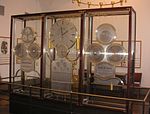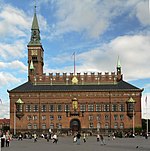Copenhagen Municipality (Danish: Københavns Kommune), also known in English as the Municipality of Copenhagen, located in the Capital Region of Denmark, is the largest of the four municipalities that constitute the City of Copenhagen (Byen København), the other three being Dragør, Frederiksberg, and Tårnby. The Municipality of Copenhagen constitutes the historical city centre and the majority of its landmarks. It is the most populous in the country with a population of 652,564 inhabitants (as of October 2022), and covers 86.4 square kilometres (33.4 sq mi) in area,. Copenhagen Municipality is located at the Zealand and Amager islands and totally surrounds Frederiksberg Municipality on all sides. The strait of Øresund lies to the east. The city of Copenhagen has grown far beyond the municipal boundaries from 1901, when Frederiksberg Municipality was made an enclave within Copenhagen Municipality. Frederiksberg has the largest population density of the municipalities of Denmark.The municipal seat of government is the Copenhagen City Hall (Danish: Københavns Rådhus), the headquarters of the Copenhagen City Council. The Lord Mayor of Copenhagen is Sophie Hæstorp Andersen, since 1 January 2022. The relationship between Copenhagen Municipality and the wider city of Copenhagen is one of an administrative unit within a significantly larger city, cf. the City of London or the City of Brussels.
In the Middle Ages, Copenhagen was defined as the area enclosed within the city walls. The city centre lies in the area originally defined by the old ramparts, which are still referred to as the Fortification Ring (Fæstningsringen) and kept as a partial green band around it. In 1856 the ramparts were pulled down allowing for growth and expansion. In 1901 the city expanded to include Amager and Valby, while Frederiksberg became an enclave within the municipality. The Finger Plan in the second half of the 20th century led to expansion outside the municipal boundary along the commuter lines of the S-train and the Lokaltog rail lines going to i.e. Helsingør (The Coast Line (Kystbanen) northbound) and Stevns Municipality (East Line (from Køge southbound) along the Øresund. The Copenhagen-Ringsted Line makes Køge one of the railway hubs of Eastern Denmark. Road and rail construction is planned to relieve traffic congestion because the narrow 14.5–15.3-kilometre (9–9.5 mi) isthmus between Roskilde Fjord and Køge Bugt (Køge Bay) forms a bottleneck.
Copenhagen Municipality was one of the three last Danish municipalities not belonging to a county, the others being Frederiksberg Municipality and Bornholm. On 1 January 2007, the municipality lost its county privileges and became part of the Capital Region of Denmark.











